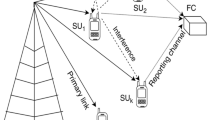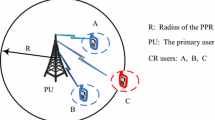Abstract
The fundamental features of cognitive radio (CR) systems are their ability to adapt to the wireless environment where they operate and their opportunistic occupation of the licensed spectrum bands assigned to the primary network. CR users in CR systems should not cause any interference to primary users (PUs) of the primary network. For this purpose, CR users need to accurately estimate the features and activities of the primary users. In this paper, a novel characterization of heterogeneous PUs and a novel reconfigurability solution in CR networks are introduced. The characterization of PUs consists of a detector and classifier that distinguishes between heterogenous PUs. The PU characteristics stored in radio environmental maps are utilized by an interference/throughput adapter for the optimization of CR parameters. The performance of the proposed solutions is evaluated by showing false alarm and missed detection probabilities of the detector/classifier in a multipath fading channel with additive white Gaussian noise. Moreover, the impact of the PU characteristics on the CR throughput is analyzed.







Similar content being viewed by others
References
Akyildiz, I. F., Lee, W.-Y., Vuran, M. C., & Mhanty, S. (2006, September). Next generation/dynamic spectrum access/cognitive radio wireless networks: A survey. Computer Networks, Elsevier, 50(13), 2127–215.
Bixio, L., Oliveri, G., Ottonello, M., & Regazzoni, C. S. (2009). OFDM recognition based on cyclostationary analysis in an Open Spectrum scenario. IEEE 69th Vehicular Technology Conference, April 26–29.
Canberk, B., Akyildiz, I. F., & Oktug, S. (2011, February). Primary user activity modeling using first-difference filter clustering and correlation in cognitive radio networks. IEEE/ACM Transactions on Networking, 19(1), 170–183.
FCC. (2002). Spectrum policy task force report. ET Docket no. 02-135.
FCC. (2003, December). Notice of proposed rule making and order. ET Docket, no. 03-222.
Goh, L. P., Lei, Z., & Chin, F. (2007, June 24–28). DVB detector for cognitive radio. IEEE international conference on communications, ICC 2007.
Hu, D., & He, L. (2010, December 6–10). Pilot design for channel estimation in OFDM-based cognitive radio systems. IEEE international conference on communications, ICC 2010, pp.1–5.
Lee, W.-Y., & Akyildiz, I. F. (2008, October). Optimal spectrum sensing framework for cognitive radio networks. IEEE Transaction on Wireless Communications, 7, 3845–3857.
Liu, H., Yu, D., & Kong, X. (2009, April 26–29). A new approach to improve signal classification in low SNR environment in spectrum sensing. IEEE 69th vehicular technology conference, VTC Spring 2009.
Mishra, S. M., Sahai, A., & Brodersen, R. W. (2006, June). Cooperative sensing among cognitive radios. In Proceedings of the IEEE ICC 2006, 4, 1658–1663.
Muraoka K., Ariyoshi, M., & Fujii, T. (2008, October 14–17). A novel spectrum-sensing method based on maximum cyclic autocorrelation selection for cognitive radio system. IEEE symposium on new frontiers in dynamic spectrum access networks, DySPAN 2008.
Musavian, L., & Aissa, S. (2009). Fundamental capacity limits of cognitive radio in fading environments with imperfect channel information. IEEE Transaction on Wireless Communication, 57(11), 3472–3480.
Proakis, J. G. (2001). Digital communications (2nd Edn.). New York: McGraw-Hill.
Shellhammer, S. J. (2008, June 9–10). SPECTRUM SENSING IN IEEE 802.22. IAPR workshop on cognitive information processing, 2008, Santorini, Greece.
da Silva, C. R. C., Brian, C., & Kim, K. (2007, January 29–2007, Febraury 2). Distributed spectrum sensing for cognitive radio systems. Information theory and applications workshop, 2007, pp. 120–123.
Stevenson, C. R., Cordeiro, C., Sofer, E., & Chouinard, G. (2005, September). Functional requirements for the 802.22 WRAN standard. IEEE 802.22-05/0007r46.
Sutton, P., Nolan, K., & Doyle, L. (2008, January). Cyclostationary signatures in practical cognitive radio applications. IEEE Journal on Selected Areas in Communications, 26, 13–24.
Vizziello, A., Akyildiz, I. F., Agustí, R., Favalli, L., & Savazzi, P. (2010, December 6–10). OFDM signal type recognition and adaptability effects in cognitive radio networks. In Proceedings of IEEE GLOBECOM 2010, Miami, Florida, USA.
Vizziello, A., & Perez-Romero, J. (2011, Ocotober 26–29). System architecture in cognitive radio networks using a radio environment map. In Proceedings of CogART 2011, (invited paper), Barcelona, Spain.
Wang, B., & Liu, K. J. R. (2011, Febraury). Advances in cognitive radio networks: A survey. IEEE Journal of Selected Topics in Signal Processing, 5(1), 5–23.
Zhao, Y., Morales, L., Gaeddert, J., Bae, K., Um, J.-S., & Reed, J. (Apr. 2007). Applying radio environment maps to cognitive wireless regional area networks. In Proceedings of IEEE DySPAN 2007, pp. 115–118.
Author information
Authors and Affiliations
Corresponding author
Additional information
The work of Ian F. Akyildiz and Ramon Agustí was supported by the European Commission in the framework of the FP7 FARAMIR Project (Ref. ICT- 248351).
Rights and permissions
About this article
Cite this article
Vizziello, A., Akyildiz, I.F., Agustí, R. et al. Characterization and exploitation of heterogeneous OFDM primary users in cognitive radio networks. Wireless Netw 19, 1073–1085 (2013). https://doi.org/10.1007/s11276-012-0519-z
Published:
Issue Date:
DOI: https://doi.org/10.1007/s11276-012-0519-z




